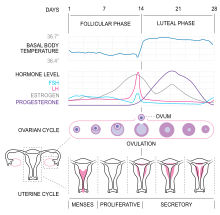User:Benningjp/Sandbox

The cycle of producing and releasing mature ova and to prepare for a possible pregnancy in human females is called the menstrual cycle. This is from the latin menstrua which means month. The cycle lasts on the average 28 days, and revolves around the release of a mature ova once in that 28 day period. The process is controlled by several hormones: FSH or follicle stimulating hormone, LH or luteinising hormone, estrogen, and progesterone. These hormones prepare the uterus to receive a fertilized egg and control the development of ova. The stages of the cycle are defined as the Follicular stage, Ovulation and the Luteal (or premenstrual) stage. The cycle will stop if implantation of and embryo in the endometrium tissue of the uterus takes place.
'
Follicular Stage
[change | change source]This stage is the start of the cycle the first day is counted as day one. This stage is triggered by a lowering of progesterone and estrogen in the blood. This drop causes the thick endometrium tissue lining the uterus to be shed. This will appear as a bleeding from the vagina. This stage lasts from 4-6 days. At the start of this stage levels of FSH released by the pituitary gland will begin to rise, this will continue for 3-4 days. FSH stimulates the maturation of several follicles, each containing an immature ova, in one of the ovaries. During this time the hormone estrogen will slowly begin to increase as it is released by the follicles formed. FSH levels will peak around the third or fourth day of menstruation. All but one of the follicles will die off (usually) and the one left will increase the amount of estrogen released into the blood. The lining of the uterus will once again begin to thicken due to the increase of estrogen and near the end of the stage levels of estrogen will peak. The levels of estrogen exert positive feedback on the pituitary gland causing it to peak the release of Luteinising hormone (LH).
Ovulation
[change | change source]The peak in LH is needed for ovulation to occur. And this peak only happens if there is a rise in estrogen at the end of the follicular stage. Thus if estrogen levels are always artificially high the jump in LH will never happen nor will ovulation. The rising levels of LH trigger the ova to mature and later cause the follicle to swell and rupture, releasing the ova into the oviduct (also called the fallopian tube). The left over cells from the follicle undergo a transformation into a structure known as the corpus luteum in the next stage. Ovulation is marked by an increase in the body temperature of the female by about 0.5 degrees celcius over normal.
'
Luteal Stage
[change | change source]The follicle cells are now a progesterone secreting structure known as the corpus luteum. These cells will increase the levels of progesterone in the body and this will trigger an increased thickening of the endometrium. The ova will continue down the ovarian duct and may or may not be fertilized in this phase. This along with a slight increase in levels of estrogen will continue until around day 22. Then levels of both will begin to fall until around the 28th day of the cycle when the corpus luteum stops its progesterone production and the levels of progesterone and estrogen reach low points. This will bring us back to a point where the cycle begins again.
Pregnancy and Conception
[change | change source]If however the ova is fertilized becoming a zygote it will begin dividing through mitosis and it will move from the oviduct into the uterus to implant in the uterine wall. In this case the levels of estrogen and progesterone will remain high and the zygote having become an embryo will form a placenta with the endometrium tissue and start to mature. The cycle then stopped and the embryo will continue to mature for the next 9 months. Progesterone and estrogen levels will stay high until the baby is ready to be birthed.
